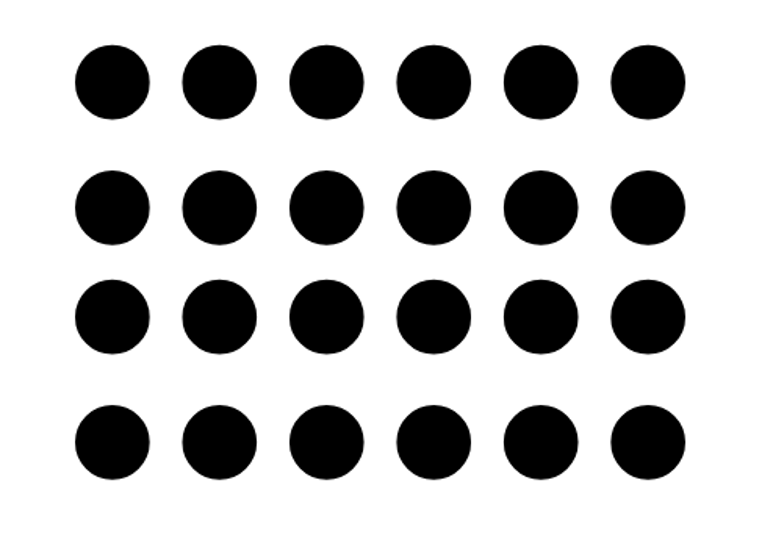A Visual Way of Learning Numbers Without Counting Gains Popularity

“Although most kids learn to subitize up to three or four by the time they go to kindergarten, there are some kids who just don’t have the opportunities, and those children are in really big trouble in kindergarten,” said Art Baroody, professor emeritus at the University of Illinois at Urbana-Champaign, who spent his career studying the best ways to teach counting, numbers and arithmetic concepts to young children. “The reason for that is subitizing involves constructing an understanding of what one is, of what two is, of what three is, of what four is, which is the conceptual basis of number sense. There’s so much that builds on that understanding.”
As children grow older, subitizing can get more sophisticated and useful for understanding more advanced math concepts. Imagine a cluster of seven dots like this:

Most people cannot subitize this many dots, especially when they’re not arranged in a familiar pattern, but they can detect subgroups. Some might see two groups of three plus an extra dot. Others might see a group of four and a group of three. There are many possibilities.
Doug Clements and Julie Sarama, a research team at the University of Denver, call this quick partitioning “conceptual subitizing.” They say it helps children compose and decompose numbers, which is useful in learning addition and subtraction facts. For example, 7 + 5 can be a tricky sum to learn. But a child who can subitize may quickly see that the 7 can be split into 5 and 2. That makes it easier to put together the two 5’s to make 10 plus 2 more to arrive at 12. “That’s meaningful and you don’t forget it,” said Clements.
Counting from 7, of course, is another approach. But it can be mentally taxing to keep track of five more as a child counts up from 7 to 12. Children who know how to add only through counting soon realize that they do not have the time to count when presented with a long addition worksheet. These children often resort to memorizing a string of meaningless numbers (5, 7, 12) that they soon forget. “They skipped the step of making it meaningful,” Clements said. “In first grade teachers will say, ‘He knew it last week. Now he forgot it.’ Well, he never really knew it.”
Subitizing seems to help with all kinds of mathematical concepts, according to its proponents. In 2014, another group of researchers described how third graders who could quickly group together sets of small numbers, such as three groups of two, had a more sophisticated understanding of multiplication and could multiply faster. Some say the ability to partition a number into smaller subitizable pieces builds an understanding of the relationship between a part and a whole and aids with fractions.
Clements and Sarama recommend using subitizing exercises through the end of elementary school. For example, an array of 24 dots can buttress a conceptual understanding of multiplication in grades three through five.

“Subitizing is not baby stuff that you move on from,” said Clements. “You just keep developing it in parallel with all the other skills you’re developing.”
Well, sometimes it actually is baby stuff. Some researchers believe that infants as young as five or six months are subitizing small numbers, such as two and three. That belief is based on experiments in which infants held their gaze longer in response to changes in quantities. As children grow older, they begin to map number words to collections of objects, for example, “two socks,” and by age 2, many children can subitize up to three items, and 4- and 5-year-old children might subitize as many as five items.
Researchers theorized that fostering this innate ability might help children build number sense. A case study of two students who struggled in math, published in 2009, found that subitizing was helpful. University of Illinois’s Baroody promoted the teaching of subitizing in a 2013 practice guide on “Teaching Math to Young Children,” for the Institute of Education Sciences, the research arm of the U.S. Department of Education.
Several studies have documented that children who have stronger subitizing abilities also tend to perform better in math. For example, a 2022 study of more than 3,600 kindergarteners in one southwestern school district found that kids who were better subitizers also had much better arithmetic abilities in first grade. A 2020 study of 80 young children, ages 2 to 5, found that the children who could subitize through the number four, and had been taught counting, could usually answer the question “How many?” But children who could subitize only to the number three demonstrated only a partial understanding of quantity.
Still, the strong correlation between subitizing and math ability isn’t proof that students will benefit from subitizing instruction. It’s possible that stronger subitizers come from wealthier families who play more board games. These higher income children also benefit from a range of other factors at home, from better nutrition to less stress, that could be driving their success in math.
The empirical evidence that it’s worthwhile to invest classroom time in subitizing is thin, at least so far. In a new, but tiny study, 14 preschoolers ages 3 to 5 were randomly assigned to two different math interventions. Those who were given more practice in subitizing performed better on a test of understanding quantity. This study, available online, is slated to be published in the December 2024 issue of the Journal of Mathematical Behavior. More and larger studies are needed.
Even without that evidence, many elementary school teachers have been incorporating aspects of subitizing, sometimes called “quick images,” into their classrooms for decades. But a more systematic teaching of this practice appears to be gaining popularity, based on interviews I’ve had with teachers, researchers and the National Council of Teachers of Mathematics, a professional organization. One motivation is a desire to address the large achievement gaps between rich and poor kids by building stronger math foundations during the earliest years. Subitizing is explicitly included in Illinois’s math standards for kindergarteners, while many other states suggest subitizing as an example of one way to teach numbers. Curriculum publishers are increasingly printing dot images for subitizing in their materials.
Beth MacDonald, an associate professor of early childhood mathematics education at Illinois State University, said subitizing was a hot topic at the International Congress on Mathematical Education earlier this summer. “People are coming and saying, ‘Oh, we want to examine this,’ ” said MacDonald, who wrote her dissertation on subitizing over a decade ago and is an author of several subitizing articles and studies that I read to write this piece.
Despite the simplicity of subitizing, experts say they sometimes see it taught incorrectly. One common mistake is to ask students to count the dots. Researchers say that undermines a child’s confidence and ability to develop mental images of sets.
Speed is essential. Often the dots are displayed for too long, long enough for children to count them. “That’s the biggest mistake,” said Clement’s partner Sarama, who explained to me that the brevity triggers children to visualize the image on their own.
Sarama says each dot exercise can be completed in 10 seconds for a total of three minutes a day. Memory for the quantities is built, according to researchers, through brief but repeated exposures.
According to the Milwaukee math coach, Robinson, kids want to talk so much about all the different ways that they see the dots that it’s hard for teachers to move on to the next activity. Kids really enjoy subitizing.
And many children learn to subitize at home. Researchers say that the practice doesn’t require fancy materials and parents don’t need to create dot cards. They advise parents to talk about quantities during everyday activities. When you’re folding laundry, talk about matching pairs of socks. Or at the end of lunch, ask who is going to eat the three french fries left on the plate. Sometimes, you don’t have to count them!
You Might Also Like
Another Education Department Delay: Release of NAEP Science Scores
A spokesman for the National Assessment Governing Board, which oversees NAEP, said the science scores will be released later this...
A Bloom’s Digital Taxonomy For Evaluating Digital Tasks
by TeachThought Staff At TeachThought, we’ve described Bloom’s Taxonomy as “a hierarchical ordering of cognitive skills that can, among countless...
12 General Critical Thinking Questions About Voting And Government – TeachThought
by Terry Heick Note: This has been updates from a 2018 version Just a quick post that’s self-explanatory enough: It’s...
A Conversion Chart For Reading Level Measurement Tools
A Conversion Chart For Reading Level Measurement Tools by TeachThought Staff If you’ve used AR (Accelerated Reader) as a reading...









